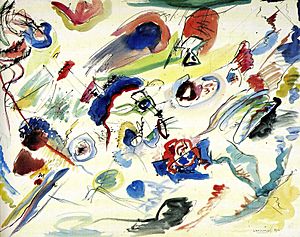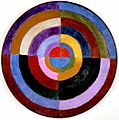Abstraction (art) facts for kids

Abstract art is a type of art that doesn't try to show things exactly as they look in the real world. Instead, it uses shapes, colors, lines, and textures to create a feeling, an idea, or a new visual experience. Think of it like music – music doesn't usually show you a picture, but it can make you feel happy, sad, or excited. Abstract art works in a similar way, using visual elements instead of sounds.
Contents
What is Abstract Art?
Abstract art moves away from showing objects, people, or places in a way that looks realistic. It's about expressing ideas or emotions using the basic building blocks of art:
- Shapes: These can be geometric, like squares and circles, or organic, like wavy, natural forms.
- Colors: Artists use colors to create moods, draw your eye, or show contrast.
- Lines: Lines can be thick or thin, straight or curvy, and they guide your eye around the artwork.
- Forms: This refers to three-dimensional shapes or the illusion of depth.
- Textures: How the surface of the art feels or looks, like rough or smooth.
Instead of painting a tree that looks exactly like a tree, an abstract artist might use green and brown shapes and lines to give you the feeling of a tree, or even just the feeling of nature.
Why Did Artists Start Making Abstract Art?
Abstract art really took off in the early 1900s. Before this, most art tried to show the world as it was. But then, artists started to think differently. They wanted to:
- Express feelings: They felt that showing things realistically sometimes limited their ability to show deep emotions.
- Explore new ideas: They were interested in science, psychology, and new ways of seeing the world.
- Focus on art itself: They wanted to make art that was about colors, shapes, and lines for their own sake, not just as tools to copy reality.
It was a time of big changes in the world, and artists wanted their art to reflect these new ways of thinking and feeling.
Different Kinds of Abstract Art
Abstract art isn't just one style; it has many different forms. Some abstract art still has a tiny hint of something real, while other types are completely non-representational, meaning they show nothing from the real world.
- Cubism: Artists like Pablo Picasso and Georges Braque broke objects into geometric shapes and showed them from many angles at once. You might still recognize a face or a guitar, but it's all broken up.
- Expressionism: This style focused on showing strong emotions through bold colors and distorted shapes. The art might be abstract, but it's meant to make you feel something intense.
- Non-objective art: This is the purest form of abstract art. It doesn't show anything from the real world at all. Artists like Piet Mondrian used simple geometric shapes and primary colors to create balanced and harmonious designs. Wassily Kandinsky created art with swirling colors and shapes that aimed to express inner feelings, like music.
Famous Abstract Artists You Should Know
Many artists helped shape the world of abstract art. Here are a few important ones:
- Wassily Kandinsky (1866–1944): A Russian artist, he is often called one of the first true abstract painters. He believed art should express inner spiritual feelings, much like music.
- Piet Mondrian (1872–1944): A Dutch artist famous for his grid-like paintings using only black lines and blocks of primary colors (red, yellow, blue) and white. His art was about balance and order.
- Jackson Pollock (1912–1956): An American artist known for his "drip paintings." He would lay a canvas on the floor and drip, pour, or splash paint onto it, creating energetic and complex patterns.
- Robert Delaunay (1885–1941): A French artist who focused on bright, contrasting colors and geometric shapes, especially circles, to create a sense of movement and light.
How to Look at Abstract Art
Looking at abstract art can be different from looking at a realistic painting. Here are some tips:
- Don't try to "figure it out": You don't always need to find a hidden object or meaning.
- Focus on your feelings: How do the colors make you feel? Does the artwork seem calm or energetic?
- Notice the elements: Look at the shapes, lines, and textures. How do they work together?
- Let your imagination go: What does the art remind you of, even if it's not a specific thing?
- Enjoy the visual experience: Sometimes, abstract art is simply beautiful to look at because of its colors and forms.
Abstract art challenges us to see the world, and art itself, in new and exciting ways. It's about expressing ideas and emotions that go beyond what we can see with our eyes.
Images for kids
-
Robert Delaunay, 1912–1913, Le Premier Disque, 134 cm, 52.7 inches, Private collection. This is a great example of abstract art using circles and bright colors.
See Also


